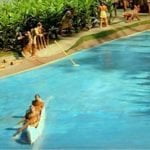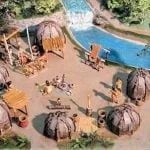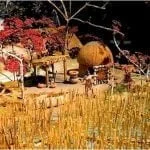Never heard of the Potawatomi Indian Tribe? The Potawatomi Nation is a sister tribe to the Ottawa and Ojibwe (Chippewa.) At one time, they were part of the same tribe and living somewhere in the vicinity of Canada’s Maritime Provinces or perhaps, New England. As the tribe gradually migrated westward along the edge of Lake Erie, it eventually broke up into three bands, which eventually became distinct tribes. The three tribes still share very similar cultural traditions and languages.
Although they never lived in permanent villages until the early 1800s, the Three Sister Tribes had very rich cultural traditions. Still today, their beadwork and paintings were some of the finest in the Native American world. They had a writing system which was preserved on bark or deer skin scrolls. The original syllabary was in use several centuries ago. It is remembered in their traditions in the appearance about 500 years ago of seven prophets carrying scrolls, which accurately predicted the future. In the 1700s, French priest developed the original glyphs into a writing system that could communicate complete sentences. Modern Ojibwe and Potawatomi writing is derived from that system.
Maple syrup candy and fresh sturgeon steaks!

By March the days were getting longer, but snow still clung to the frozen landscape. The triple walled teepees were still necessary habitation to avoid frostbite. However, the maple trees somehow knew that spring’s warmth was imminent. The maple sap began rising. It was time to go into the forest; tap holes through the bark of the maples; and attach birch bark buckets underneath the holes. For the Potawatomi children, it was one of the most joyous times of the year. By mid-March enough sap had collected for the women to start boiling in down into syrup and sugar. Meanwhile the men had carved wooden molds set form to the hot, viscous syrup the women would ladle from the big ceramic pots. If the children had been especially good during the past year, grandmother just might slip them a chunk of maple candy. Another favorite dessert was maple ice cream, made from clean snow and big spoonful of maple syrup.
Early spring was the time when the winter camp would be partially dismantled. Some of the women, children and elderly might even start the trek to the summer village by the lake, but the men, boys and younger women headed to the shoals and waterfalls of rivers where the sturgeon were running up stream to spawn. The boys and girls made fishing poles and sat on the banks of calmer sections of the rivers to catch trout, lake salmon and perch. Teenage boys cast nets into the water or built v-shaped rock dams. A cone shape basket, woven out of split oak, would trap small fish as they tried to exit the dam.
The grown men, though, stood on the cliffs next to shoals and waterfalls to throw their spears at the sturgeons jumping out of the water to climb the rapids. Many sturgeons weighed over 200 pounds. One successful spear throw could feed the band for several days. Sturgeon meat that was not eaten immediately, was sliced thin, and smoked on wood lattice grills over slow fires. Sturgeon eggs were harvested to give extra nutrition to pregnant or nursing women. Very little was wasted.
The architecture of the fishing camps rarely was more than lean-to sheds or lightweight teepees. Some springtime nights could drop down below freezing near the Great Lakes, but by this time the young and the vigorous were thoroughly adapted to cold weather. Those who couldn’t tolerate the cold night air because of illness or age, hiked on down to the main village composed of sturdy wigwams.
Corn, beans, squash, sunflower seeds, pumpkins and lots of fish on the grill

The Potawatomi maintained permanent buildings in villages near flat, bottomland suitable for gardening and lakes, where fish were plentiful. It was here that the entire village would gather to live for about five months. During the remainder of the year, the members of the village dispersed into small extended family households in order to seek out food resources.
It is currently believed by archaeologists that most of their buildings in these main villages were wigwams that varied in size according to usage. (See article on wigwams.) There were also simple open sheds that served as outdoor living rooms and kitchens. The village chief lived in a wigwam large enough to hold small meetings, although most ceremonies and meetings were held outside, if possible. Young couples lived in small wigwams that were adequate for them and a babe or two. Mature families would build wigwams adequate for the size of their family. Young, single men might live together in large wigwams, where they learned the skills necessary for hunting and warfare from older men. Widowed elderly members of the community either would have very small wigwams or live with relatives.
The wigwams were clustered in a circle around a small, earthen plaza. In most villages a communal fire in the center of the plaza was the focal point for dances and ceremonies. It was here that women would congregate to socialize while doing their daily chores.
The wigwams were framed with a latticework of saplings and sheaved with elm bark shingles. The spherical roofs kept out the rain, diffused high winds, let smoke out through the ceiling, but would not insulate the occupants from cold temperatures. They were also modular and transportable. If the village leaders decided that another location would be a more productive site for gardening and fishing, the existing village would be dismantled and carried on the backs of his occupants to the new habitation place.
Apparently, Potawatomi villages were not protected by timber palisades until after the intrigues and greed of competing European nations inflamed warfare between several indigenous ethnic groups. European traders typically wanted high quality furs and skins as barter for European manufactured goods. Hunters no longer limited their game to what was needed for food. Large numbers of animals were slaughtered for their furs and skins at distances too great to transport the meat back to the home village. Excessive hunting reduced the number of animals in the forests, and therefore caused non-related ethnic groups to fight bitter wars of extermination for the control of hunting lands. The small Potawatomi villages were vulnerable to raids by wide-ranging Iroquois war parties, and therefore had to be fortified against surprise attacks.
Although the Great Lakes tribes began cultivation of crops much later than the Southeastern and Southwestern peoples, they, nevertheless, were producing significant proportions of their diet from crops by the time contact was made with European explorers and missionaries. The Potawatomi did not maintain large cultivated fields like the Southeastern tribes. Their cultivation practices usually consisted of small family cultivated gardens, which were moved around year to year in order to avoid depletion of soil fertility.
Women and girls cultivated the gardens, which usually contained several types of corn, several types of beans, several types of squash, sunflowers, tobacco and pumpkins. While the women were busy maintaining and harvesting the gardens, the men and boys were either fishing in the lakes or hunting in the forests. The Potawatomi had domesticated dogs and ducks, which supplied some animal protein, but most of their animal protein came from the forests and the water.
None of the crops were indigenous to the Great Lakes Region. They first had been slowly domesticated in the Southeast or Mexico, then over the centuries slowly adapted to the cooler weather and shorter growing seasons of the Great Lakes. None of the seeds of crops developed in Mexico could have possibly been taken straight from Mexico to the Great Lakes, without modification of the environmental needs.
Extensive contacts with French missionaries radically changed the villages and architecture of the Potawatomi. The new lifestyle of the Potawatomi in the early 1800s is described in the article on “Log cabins and livestock.”
Wild rice, smoked venison and lots of fish on the grill

Late summer and early autumn were a busy time in a Potawatomi village. Because of the short growing season, most of the vegetables became ripe enough to harvest in the late summer. While the corn was drying on the stalks in early autumn, most of the able-bodied people of the village dispersed in family bands to harvest their designated thicket of wild rice. Some of the teenagers stayed in the village to protect the corn and harvested vegetables from roaming animals. Elders sliced the pumpkins and squash, and then dried the slices of vegetables along with the beans, in the sun.
Wild rice was “the staff of life” for the three Sister Tribes and performed the same important nutritional role among Great Lakes Indians as corn did in the Southeast and Southwest. It is not true rice in the sense that we label Asian rice. It is a distinct wild grain that contains quite a bit more nutrition than the domesticated rice today. It only grows in water or wetlands, so it was necessary for the Potawatomi extended family bands to set up campsites or hamlets near the stands of rice.
There are two main varieties of North American wild rice, Northern Lake Rice and Southern Marsh Rice. The Northern Lake Rice grew at the tops of stalks that could reach eight feet in height. It grew on the edges of clear deep lakes. Southern Marsh Rice grows in shallow seasonal wetlands. Its life cycle is much more similar to Asian rice, in that it sprouts after the spring floods and then matures during the summer after the land has dried out.
Today, surviving stands of Southern Marsh Rice are about the height of Asian rice or wheat, when mature. However, this may be the result of crossing of wild and cultivated varieties in the past. Northern Lake Rice was never cultivated by the Native Americans, but is grown commercially today. Muskogean (Creek. Choctaw, Alabama, etc.) Indian towns intentionally located near seasonal riverine wetlands so that such water-loving crops as Marsh Rice could be grown, However, it was probably never an important source of nutrition in the Southeast, but rather was used to provide variety to meals . . . in the same way that wild rice today provides tasty variety to American meals.
Northern wild rice is harvested by striking the plants with wooden staffs, causing most of the kernels to fall into wooden dugout canoes. Those that fall into the water, sprout the next spring and renew the crop. Southern wild rice was harvested with a sickle, in the same manner than pre-industrial farmers harvested wheat.
While some members of the family were harvesting the wild rice, others built spherical temporary houses that were woven like baskets. These were almost identical to the woven houses built by Native Americans on the South Atlantic and Gulf Coasts for fishing camps. (See article on woven basket houses.) Evidently, woven houses were an architectural tradition among Native Americans throughout much of the Eastern United States. The Potawatomi basket houses were woven from the leaves and stalks of cattails, whereas the Southeastern basket houses were made from durable palmetto fronds. Cattail fronds quickly decompose when exposed to rain. Thus, the Potawatomi houses barely lasted the length of the wild rice harvesting season.
While some Potawatomi were still harvesting the remaining ripe kernels of wild rice or going out into the forests to gather nuts, others began drying and processing the kernels. It was necessary to beat them and then winnow them with baskets in order to separate the inedible outer hulls from the nutritious kernels. The dried kernels would then be stored in baskets, and made ready for the trek to the winter camping site.
Wild rice requires extensive soaking in water and cooking before it is soft enough to eat. Thus, part of the work day of a Potawatomi woman involved pouring the dry kernels into pots so that they could soak for a day or two. Cooking the wild rice might require several hours over the fire.
Mid-autumn was the prime hunting season for deer, elk, moose and bears. If the weather had been good that summer, these animals would be plump from feasting on the recently fallen nuts. Also, in the Great Lakes Region, mid-autumn brought on freezing temperatures at night, which slowed down the decay of meat until the carcasses could be brought to camp, sliced and smoked. Of course, some nuts, animal meat and wild rice were consumed immediately, so the Potawatomi, themselves, could build up fat reserves in their bodies for the long winter ahead.
The arrival of Europeans in Eastern Canada and New England in the early 1600s started a catastrophic series of changes in the harmonious lifestyles of the Potawatomi People. Invisible killers periodically crept inland from the coast that caused diseases that the Potawatomi healers had never seen. The intermittent plagues could have started as soon as the mid-1500s.
By the mid-1600s war parties from the Iroquois Confederacy were ranging deep into the Great Lakes Region to clear wide swaths of the landscape for their hunting grounds. Simultaneously, the Rickohockens sent raiding parties from their mountain homeland in SW Virginia to obtain Native American slaves for Virginia planters. By the late 1600s, it was the Cherokees who became the main terror of the Midwest. Until around 1720 the main source of income for the Cherokees was the Native American slave trade. Cherokee slave raiders armed with muskets repeatedly attacked the Erie and southern Potawatomi villages until the Great Lakes tribes obtained firearms from the French.
The Potawatomi eagerly established friendly relations with the newly arrived French colonists and soldiers in Quebec. An alliance with France provided protection from Native American raiders, who were allied with England, such as the Iroquois, Rickohockens and Cherokees. The French built forts and fortified trading posts in Potawatomi territory. Extensive contacts with French missionaries radically changed the villages and architecture of the Potawatomi. The new lifestyle of the Potawatomi in the early 1800s is described in the article on “Log cabins and livestock.”
Hunkering down in the winter time

As the first snow flurries floated down in the autumn, small family bands of the Potawatomi left the lake basins and journeyed up into the hills, where ridges would block the bitter winter winds and the forests would provide game to hunt. This was a hard trek because they had to carry on their backs all of the food they had harvested or preserved during the warm months. Much of the non-perishable food supply consisted of wild rice, dried fish plus some corn, beans and dried squash. To be sure of surviving the winter in good health, though, they would be dependent on the men bringing in at least some large game such as elk, deer and bison.
Most readers would be surprised to learn that the winter homes of the Potawatomi were teepees! In fact, many Midwestern tribes lived in teepees during the winter time. The double-lined hide walls completely blocked the winter winds while simultaneously keeping the heat from modest interior hearths from escaping. The Potawatomi added an outer sheaving of reeds, which caused melting snow to drip down to the ground, rather than saturating the hides and causing them to rot.
The Lakota, Nakota and Dakota (Sioux) formerly lived in the Great Lakes Basin. They lived in teepees during the winter before ever venturing out into the Western Plains.
The Citizen Potawatomi Nation operates a 36,000 square feet cultural heritage center in Shawnee, Oklahoma. The photos displayed in this series of articles are of models in this museum. Shawnee is about an hour’s drive from Tulsa.
